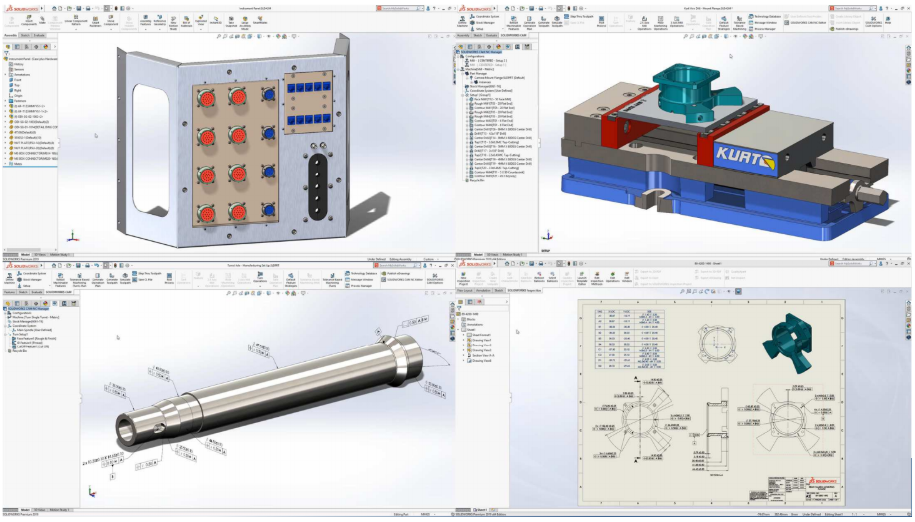![[Image: SOLIDWORKS]](https://fabbaloo.com/wp-content/uploads/2020/05/sw195_img_5eb0a77e7e491.png)
“Performance is the biggest enhancement we have done”: a conversation on the unveiling of SOLIDWORKS 2019.
SOLIDWORKS holds a special place in the hearts — and computers — of engineers and designers the world over. Each year, new capabilities are released following careful development in response to market needs, with the updates often being long anticipated. I spoke with Manish Kumar, SOLIDWORKS R&D Vice President at Dassault Systèmes, ahead of the latest update for a look behind the curtain of one of the world’s most popular software platforms.
“In any new release of SOLIDWORKS, we try to do a lot of enhancements,” Kumar told me.
One of the biggest highlights for Kumar and his team was in performance, “especially in the context of large assemblies.” To highlight this, they selected the Canada France Hawaii Telescope, stationed atop a volcano crater in Hawaii, to present the capabilities.
The telescope, Kumar noted, is a “true leader in its own space” thanks to not only its size, but its first-in-class parts and assemblies. While the bottom structure of the telescope was set to stay the same, the plan for its update focused on a replacement of the top part. SOLIDWORKS’ four areas of improvement for the 2019 edition — performance, attention to detail, innovations, and design ecosystem — created a solid fit with the telescope’s unique needs.
![[Image: SOLIDWORKS]](https://fabbaloo.com/wp-content/uploads/2020/05/image32_img_5eb0a77f298b3.png)
“When we say we are enhancing SOLIDWORKS, we are not just talking about CAD, but the whole ecosystem. We visit a lot of customers, take their input into account,” Kumar continued. “We have a website where customers can put their enhancement requests.”
Among some of the enhancements are the ability to edit in Large Design View, group mates / tool rotation lock, silhouette defeature, and an exploded views overhaul — set to “make it easier to use and offer more freedom for our users, so they are able to tackle their biggest design issues.”
In SOLIDWORKS 2018, the team added mesh capabilities; in the 2019 edition, users can now “slice that mesh body and create protected sketches using mesh,” Kumar noted.
“The reason why we do it is mesh is good for 3D printing, which is the key reason why we tried to incorporate mesh in 2018. To go into mass production, you need a precise geometry which you can offset, which can be shelled, and so on, so there’s added capability for users to convert mesh into different slices to recreate a very precise geometry. You can do whatever you want at that point,” he said. “We added 3D texture; creating bumps in a texture is very easy. We try to use that information to get a 3D point cloud with which we create meshes. We have done enhancements in sketches where you can for example open profiles and protect in multiple places. This used to be a multi-stage process, and now is one.”
![[Image: SOLIDWORKS]](https://fabbaloo.com/wp-content/uploads/2020/05/image6328229_img_5eb0a77fac25e.png)
A larger view is that SOLIDWORKS 2019 is geared toward providing a “design to manufacturing complete solution.”
A markup view allows for easy collaboration; with a touch device, the enhanced touch support allows users to write onto their screen and have the option to export as a .jpg, .pdf, .png, or other formats to share for collaborative purposes.
Files can also be opened in AR or VR to “experience any virtual thing as if you were there.”
“These are innovations that move you to the next generation,” Kumar noted.
Especially relevant for 3D printing, in SOLIDWORKS 2019 “we tried to make sure that once you have mesh in any environment, we are going to make modification of that mesh very easy,” he explained. “We have also added some more tools where you bring in mesh from other environments.”
Looking toward topology optimization, in SOLIDWORKS users can “define various constraints and conditions, it defines the geometry you should be creating. We have added more constraints there, in SOLIDWORKS 2019 you can define more: factor of safety, maximum or minimum stress value, frequency constraints. Based on that, you can generate the optimized topology, we have added export to mesh capability so that if you have a design suggested by topology optimization, you do not have to worry about converting to precise geometry — convert to mesh and start the 3D print,” Kumar said.
“We did add a lot of enhancements to make our users’ lives easier if they are focused on 3D printing capabilities.”
Overall, the keys for the team behind SOLIDWORKS 2019 come back to innovation.
Kumar explained that his biggest focus has been on adding a lot of performance for SOLIDWORKS’ largest customers who are creating large assemblies. Looking ahead to future needs in design has also been at the forefront of thought.
![[Image: SOLIDWORKS]](https://fabbaloo.com/wp-content/uploads/2020/05/sw193_img_5eb0a7801b35f.png)
“We are focusing on the innovative areas, trying to keep a balance between what our existing customers need and ensuring that they have everything they need in their bags for the day-to-day, and at the same time focusing on futuristic needs.
“AR, VR, 3D printing: all these are areas where we are trying to ensure we have all possible tools and enhancements so when people are ready to use them, they can use them,” Kumar noted.
“The two big takeaways are this: Performance is the biggest enhancement we have done. But we are also keeping our eyes set on the future, taking futuristic innovations into account when we plan for the next release.”
A live event online today, September 12th, beginning at 11:00am ET and continuing throughout the day — and available on-demand afterward — on Facebook and YouTube will present more information about SOLIDWORKS 2019 and the Canada France Hawaii Telescope.
More information on what’s new from SOLIDWORKS is also available here.
Via SOLIDWORKS











MiniFactory’s new software produces a very useful report for each 3D print that may be important for clients. We had a close look at one.